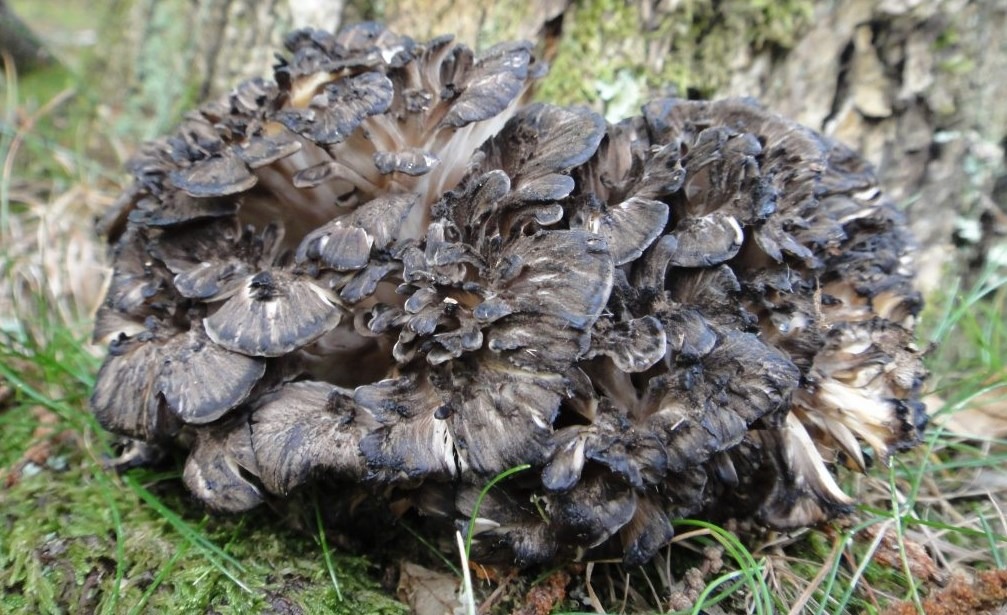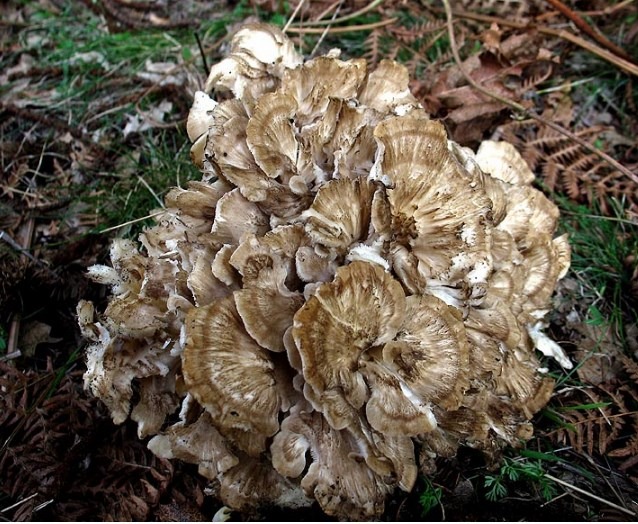The Grifola Frondosa is a mushroom belonging to the genus Grifola, to the family of the Meripilaceae, to the order Polyporales and, more generally, to the class Basidiomycetes, which includes most of the common fungi, that is, those with stipe and cap.
The name of the Grifola comes from the Greek “grifos” = network of intertwined reeds and from the Latin “frondosus” = leafy because of its shape which recalls the foliage of a plant.
The aspect of this fungus is particular because it is caespitose, it looks like a very ramified bush because it is formed by many individuals.

Introduction to Grifola frondosa
The maitake mushroom is a fungus that can reach remarkable dimensions, is not very common and can, however, be found also in the following years in the same place.
The Grifola is a saprophyte-parasite fungus that prefers deciduous forests and especially the cut chestnut trees or their roots or trunks on which it grows.
Being a parasite, it can lead to the death of the plant that hosts it because its mycelium is particularly resistant even for years and ends up damaging it irreparably.
This type of mushroom is a species that is found throughout the European continent and also in the rest of the world especially in Japan where it is called Maitake and is much appreciated.
Other names of the Grifola Frondosa
The Grifola is also called the Maitake mushroom. In Italy, each area has its own name for this mushroom, which therefore boasts several, here are a few: Grifo, Grifone, in the Reggio Apennines and in the province of Lucca, Grifola, Royal Mushroom, Polipero frondoso, Barbagina or Barbagino in Liguria, Cavazza in Lunigiana, Quarin or Berbesin in Piedmont, Nasca in Calabria, Fungagnino in the province of Pistoia.
In Japan, as we have already said, it is called Maitake, which means “dancing mushroom”.
Description of Maitake mushroom
The fruiting body of the Griffon vulture, or carpophore, is often formed by hundreds of individuals and can reach even 70 cm.
The stipe is whitish, short and may have several ramifications.
At the apex of the branching, fan-shaped hats are formed which resemble boxes or superimposed shelves.
It can reach and sometimes exceed 15 kg in weight.
According to recent studies, it seems to have strong medicinal properties.
Cap
The cap of the leafy griffin has an irregular surface, wrinkled, flat and not very convex. It has the shape of a fan and is connected to the stipe laterally. The colour ranges from grey to brown with darker areas.
The dimensions of each individual forming the cap varies from 2 to 12 cm and everything can reach even a diameter of 40-50 cm of diameter and more, up to even 70 cm.
Hymenophore
The hymenophore, that is, the lower part of the cap, is formed by tubules, very thin small tubes which have this type of fungus.
They are short and dense, whitish in colour.
They end with pores that, initially, are very small while when they reach maturity, when they release the spores, they become angular and wider.
Stipe
From the main stem of the Griffon vulture or leafy griffin, which is whitish and fleshy develop numerous branches and forks of flattened shape that end in a fan-shaped cap as described above.
Flesh of Maitake Mushroom
The flesh of the Maitake mushroom is white, immutable, tenacious, especially towards the base of the young fungus, whilst it becomes frail towards the cap.
Over time, the characters get worse.
The smell of Polyporus frondousus is penetrating, intense but not easily definable in the young individual but, as it ages, its flesh becomes leathery.
The taste is pleasant and delicate and the smell stronger and stronger until it becomes nauseating.
Habitat of Grifola frondosa
The fungus Grifola frondosa grows at the base of many broad-leaved trees, especially chestnut and oak trees.
It is located from the end of August to October in the woods with hot and humid climate.
It develops, in particular on the recently cut or dead strains of chestnut trees (characteristic saprophyte), where it occurs again, in the same place, in alternate years (every 2-4 years) or on trees for which, with the time, it will determine their death (characteristic parasite).
It is not easy to find it every year and it is not a very common fungus, but it is harmful because its persistent mycelium damages and leads to death of the host plant.
If you find it once you return to check the same place in the following years.
Edibility of the Grifola frondosa mushroom
Edibility is excellent. Considering that the griffon mushroom is a rather rare mushroom and must be consumed as a young person, the Grifola frondosa was formerly used for Sunday lunch.
You can eat fried or stewed with polenta, trifolato with garlic and parsley.
It is very suitable for storage in oil, because in this way it is able to express the best of goodness.

Medicinal qualities of the Maitake Mushroom
Maitake is rich in minerals, potassium, calcium and magnesium, vitamins B2, D2 and niacin, fibre and amino acids.
The Polyporus frondousus is cholesterol-free.
It has an active constituent that enhances and exalts the immune activity identified quite recently and its action is quite relevant in humans.
It is mainly used for the prevention of cancer and especially in lung cancer because it is believed that it activates some protections with anti-tumor activity.
It regulates blood pressure, blood glucose, insulin, cholesterol, triglycerides, lipids in the liver.
It also promotes ovulation in women with ovarian polycystosis.
In China is in Japan the maitake fungus is used to stimulate the immune system
However, the Polyporus frondousus should be used with caution, because in some individuals it seems to have triggered allergic reactions.
IDENTITY CARD
CAP COLOR: from grey to brown
PORES: white
FLESH: White
SMELL: Strong
TASTE: Pleasant
SPORE: white
HABITAT: Hardwoods
Did you find what you were looking for? See also here: